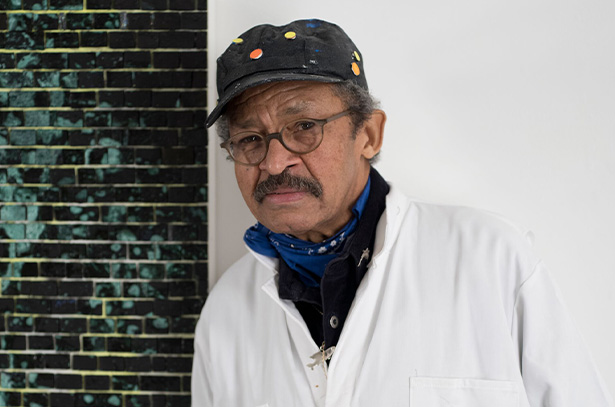
Arshile Gorky &
Jack Whitten
20 May 2020
Online Exhibition
Arshile Gorky and Jack Whitten, two consummate master artists of the 20th century, are shown together in this online exhibition. The presentation was inspired by Whitten himself, who paid tribute to Gorky in a speech he gave in 2017. ‘Arshile Gorky was my first love in painting,’ he explained, ‘it was Gorky who first excited my imagination.’ Whitten described the experience of looking at Gorky’s work as, ‘witnessing something that comes from the deep soul of an artist.’
Belonging to different generations, each artist developed a highly individual visual vocabulary within their oeuvre. Gorky played a pivotal role in the shift to abstraction that transformed 20th-century American art, bridging surrealism and abstract expressionism. By absorbing and reacting to the work of ancient and past masters, as well as contemporary artists, he asserted his own understanding and imagination; a traditionalist sensibility in an American vanguard context. Whitten made it his mission to disrupt the discipline of art history through experiments with material, process, and technique. He effectively constructed a bridge between gestural abstraction and process art.
During Whitten’s intimate tribute he emphasized the soul, color, and profound mastery present in Gorky’s work and its resonance, explaining: ‘I too have suffered at the hands of man’s inhumanity to man. Gorky knew how, what this does of the psyche... I can read it in the color structure’. The connection between these two artists is poignantly revealed in this exhibition, through the final work created by Jack Whitten in 2017 before his passing in January 2018, a homage to Arshile Gorky. Titled ‘Quantum Wall, VIII (For Arshile Gorky, My First Love In Painting)’, the work is constituted by a colorful array of acrylic paint tiles that both physically and metaphorically reflect the light, sensibility, and impression Gorky’s work left on the artist’s mind and imagination.
Both Gorky and Whitten turned to the natural world for solace and inspiration, often employing landscape motifs to express underlying emotions. Gorky spent extended periods of time between 1943 and 1946 at Crooked Run Farm in Virginia, becoming enchanted by the bucolic surroundings, and his response began to manifest in his vibrant compositions. As he explained, ‘I do not paint in front of, but from within nature.’ The resulting works, including ‘Untitled’ drawings and ‘Virginia Landscape’ from 1944 – 1945, are filled with organic forms and infused with extraordinary expressive freedom, marking a profound reawakening of his connection to nature. In the last few years of his life, between 1946 – 1948, Gorky goes on to make arguably some of his most iconic works, such as the remarkable ‘Pastoral’ (1947), rediscovered in 2010, using gestural planes of color that give shape to the negative space and seeming to emerge from within the canvas. As well as his masterful ‘Gray Drawing for Pastoral’ (ca. 1946 – 1947), his instinctive symbols – still amorphous and suggestive – form a distinctive vocabulary comprising recurring forms.
About the Artists

Jack Whitten
Born in Bessemer, Alabama in 1939, Jack Whitten is celebrated for his innovative processes of applying paint to the surface of his canvases and transfiguring their material terrains. Although Whitten initially aligned with the New York circle of abstract expressionists active in the 1960s, his work gradually distanced from the movement's aesthetic philosophy and formal concerns, focusing more intensely on the experimental aspects of process and technique that came to define his practice.
The subtle visual tempos and formal techniques embedded in Whitten's work speak to the varied contexts of his early life. After a brief period studying medicine at the Tuskegee Institute in Alabama in the late 1950s, Whitten pivoted his attentions to art, first attending the Southern University in Baton Rouge before moving to New York and enrolling at The Cooper Union for the Advancement of Science and Art in 1960, where he earned his BFA degree.
In the 1970s, Whitten's experiments with the materiality of paint reached a climax—removing a thick slab of acrylic paint from its support, Whitten realized that the medium could be coaxed into the form of an independent object. Whitten used this mode of experimentation to challenge pre-existing notions of dimensionality in painting, repeatedly layering slices of acrylic ribbon in uneven fields of wet paint to mimic the application of mosaic tessarae to wet masonry. Over the course of a six decade career, Whitten's work bridged rhythms of gestural abstraction and process art, arriving at a nuanced language of painting, which hovers between mechanical automation and intensely personal expression.

Arshile Gorky
Arshile Gorky was born an ethnic Armenian in Khorkom, Van, Ottoman Empire (present-day Türkiye) in c. 1904. Fleeing the genocide that claimed the life of his mother, he immigrated to the United States as a teenage refugee in 1920. After four years with relatives in Massachusetts, Gorky moved to New York and changed his name in honor of the celebrated Russian poet. Refusing all categories, whether artistic or political, as necessarily reductive, Gorky forsook assimilation in favor of celebrating his otherness, becoming a central figure of the cultural milieu of a city on the brink of Modernism.
After a decade of working in New York, where he achieved a prominent position as a leading artist, Gorky initiated a series of studies and paintings observed from nature while on holiday in Connecticut first, and then over two summers at a farm in Virginia. Frequently returning to fragmentary and idealized elements of his early life, Gorky incorporated memories from his childhood as well as his adult fears and desires, among the reality of his surroundings.
Current Exhibitions
1 / 12















